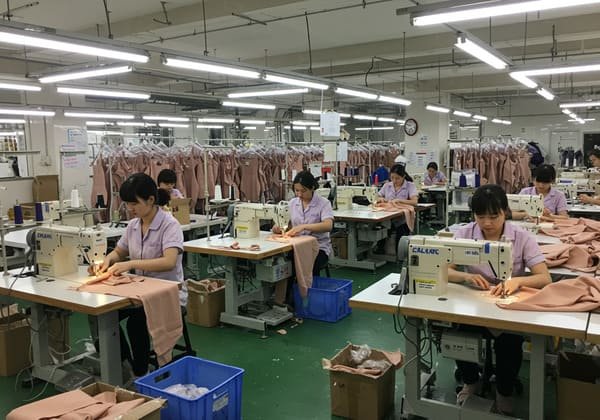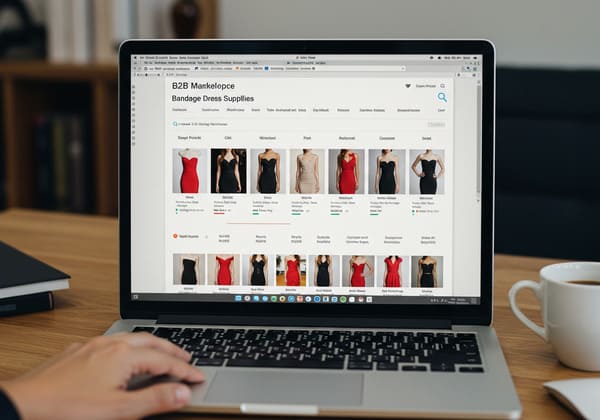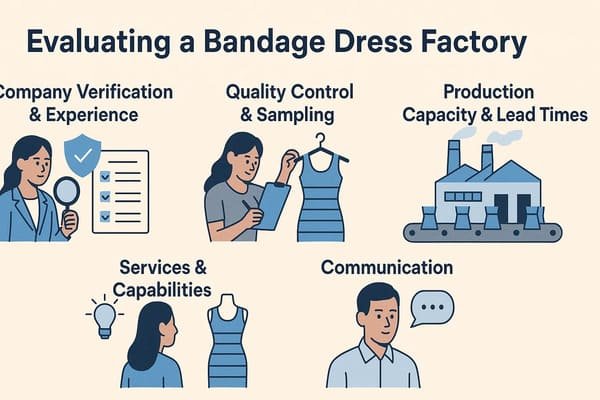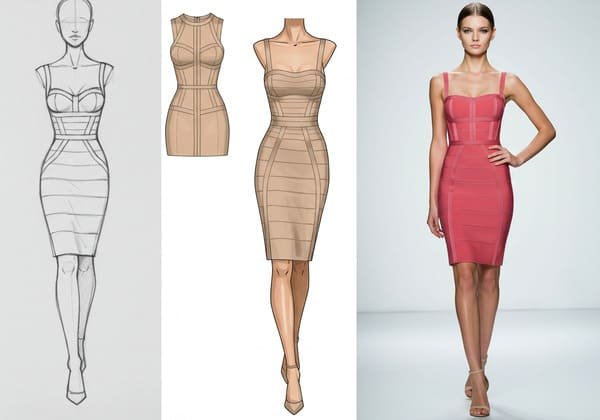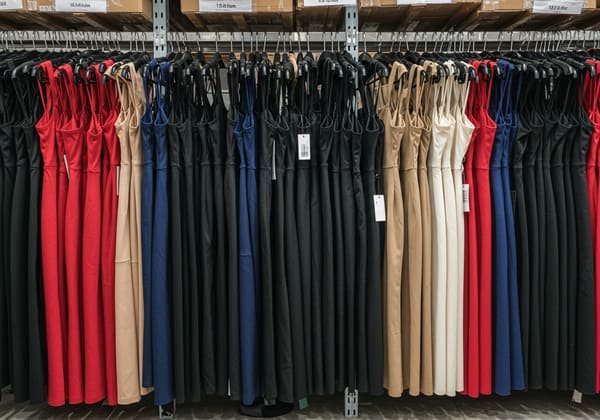Feeling unsure about sourcing fashion like bandage dresses from China?
Worries about quality, finding trustworthy partners, or handling logistics are common.
This guide aims to make the process clear and manageable for your business.
Sourcing bandage dresses from China involves a few key steps for success.
Start by understanding the product and market.
Next, find suppliers on platforms like Alibaba or at trade shows.
Then, evaluate their quality and capacity, negotiate terms, and manage shipping.
Lastly, focus on building strong partnerships.
Let’s break down these steps.
I’m Penny Pan from Fangbei, a dedicated bandage dress factory, and I’ve guided many businesses like yours.
I’ll share practical insights to help you source with confidence.
Follow along to learn the specifics.
Understanding Bandage Dresses: Styles and Market Trends?
Trying to source without truly knowing the product is a gamble.
You might pick unpopular styles or miss key trends.
Grasping the unique qualities of bandage dresses is your essential first step for success.
Bandage dresses are famous for their figure-hugging fit, achieved using heavy, stretch-knit fabric bands (usually rayon, nylon, spandex).
Popular styles include classic midis, minis, bandage 2 piece sets, and chic jumpsuits, ideal for parties and evening events.
Fabric, Fit, and Fashion Cycles for Bandage Dress Buyers
Knowing bandage dresses means appreciating the details that drive demand and understanding market shifts.
-
The Signature Fabric: The essence of a quality bandage dress lies in its fabric blend.
It’s a heavyweight knit, typically combining:- Rayon: For softness.
- Nylon: For durability.
- Spandex: For the crucial body-contouring stretch.
- Why it Matters: The right blend and weight ensure the desired fit and premium feel.
At Fangbei, our own spinning mill gives us strict control over fabric quality – a key advantage.
-
Key Silhouettes: Beyond the classic bodycon, the category includes:
- Bodycon Dresses: Timeless midi or mini lengths.
- Bandage Skirt Sets & Two-Piece Sets: Offer mix-and-match versatility and are increasingly popular.
- Bandage Jumpsuits: A modern, full-body statement piece.
- Design Details: Look for variations like off-the-shoulder necklines, cutouts, embellishments, and diverse strap styles.
-
Market & Trends: These bandage dresses are primarily for evening wear and special occasions.
- Colors: Staples like black, white, and red are always in demand, but watch for seasonal color trends.
- Design Elements: Trends influence details like cutout placement or embellishment types.
Our design team at Fangbei stays current and updates dozens of new bandage dress styles monthly (check our Homepage for ideas). - Target Customer: Usually fashion-forward individuals seeking glamorous party attire.
Knowing your specific customer is vital for selecting the right inventory of bandage dresses.
Preparing to Source: Market Research and Product Selection
Starting sourcing without a clear roadmap leads to wasted resources.
You might pursue the wrong products or suppliers.
Thorough preparation is vital before contacting any bandage dress supplier.
Effective preparation means researching your target market and competitors, then clearly defining your product needs: styles, sizes, quantities, and quality standards.
This groundwork is essential for finding the right bandage dress wholesaler or manufacturer.
Defining Your Needs and Strategy for Bandage Dress Retailer Customers
Before reaching out to potential partners, solidify your plan.
This saves time and prevents confusion later.
-
- Target Customer: Who are they? Boutique shoppers? Online buyers?
Define their style preferences and price sensitivity. - Location: Consider regional style differences (e.g., North America vs. Europe).
As a global bandage dress exporter, Fangbei understands these variations. - Competitors: Analyze what other bandage dress retailers offer.
Identify pricing, popular styles, and potential market gaps.
- Target Customer: Who are they? Boutique shoppers? Online buyers?
-
Product Specification:
- Styles: Be specific about silhouettes, colors, and design details. Use references, perhaps from our 2025 Bandage Dress Catalog, or provide your own tech packs for custom (OEM/ODM) orders.
- Sizing: Define the required size range and measurements clearly.
- Quality: Specify fabric weight, stitching standards, and finishing.
Aim for premium or budget-friendly? (Fangbei focuses on premium). - Quantity: Estimate initial order quantities (MOQ) per style/color and potential reorder volume.
-
Budget and Timeline:
- Costing: Estimate your target landed cost per unit (product + shipping + duties).
- Timeline: Plan realistically for sampling, production, shipping, and customs. We prioritize fast delivery at Fangbei.
-
Sourcing Strategy:
- Supplier Number: Decide whether to use one primary bandage dress manufacturer or diversify.
- Service Model: Need custom designs (OEM/ODM) or wholesale purchasing from a catalog?
Fangbei offers comprehensive services.
Documenting these points ensures efficient communication with potential suppliers.
Finding Reliable Bandage Dress Suppliers in China?
Knowing what you need is step one, finding the right bandage dress manufacturer is step two.
The vast number of suppliers in China can be overwhelming.
Focusing your search strategically is crucial to avoid costly mistakes.
You can find dependable bandage dress suppliers and manufacturers through online B2B platforms like Alibaba, industry trade shows, network referrals, or targeted online searches using specific keywords related to bandage dress wholesale.
Strategies to Find a Leading Bandage Dress Factory
Finding a trustworthy Trendsetting bandage dress factory requires a systematic approach.
Here are the main channels:
-
Online B2B Marketplaces (e.g., Alibaba):
- Pros: Huge database, filters, supplier verification. Fangbei is active here.
- Cons: Requires careful vetting beyond platform checks.
- Tips: Use specific search terms ("premium bandage dress manufacturer Guangdong").
Look for specialists. Check profiles and reviews.
-
Industry Trade Shows (e.g., Canton Fair):
- Pros: Meet suppliers face-to-face, inspect samples directly, build relationships. We often attend.
- Cons: Requires travel budget and time.
- Tips: Prepare by identifying relevant exhibitors. Schedule meetings.
-
Direct Online Search (Google):
- Pros: Can uncover suppliers with strong websites but less marketplace presence.
- Cons: Harder to verify credibility initially.
- Tips: Use keywords like "bandage dress factory China," "custom bandage dress supplier,".
Look for professional sites with detailed info.
-
Industry Referrals:
- Pros: Recommendations from trusted contacts often lead to good partners.
- Cons: Depends on your network.
- Tips: Ask non-competing buyers or industry consultants.
-
Sourcing Agents:
- Pros: Local expertise, vetting, communication management.
- Cons: Adds cost. Requires finding a reliable agent.
- Tips: Useful for newcomers or complex needs.
Using a combination of these channels often yields the best results.
Aim for a shortlist of promising bandage dress suppliers for evaluation.
Evaluating Bandage Dress Suppliers: Quality, Capacity, and Services
Identifying potential suppliers isn’t enough, thorough vetting is essential.
Partnering with a bandage dress supplier unable to meet quality or volume needs risks your business.
Rigorous evaluation protects your investment and brand reputation.
Evaluating potential bandage dress suppliers means assessing their manufacturing expertise, checking quality control (samples are vital), confirming production capacity and lead times, verifying certifications, rating communication, and understanding their services (OEM/ODM).
Key Areas for Bandage Dress Supplier Assessment
Due diligence is crucial when selecting a bandage dress manufacturer.
Don’t cut corners here.
I recall helping a bandage dress wholesale buyer avoid a potential disaster by properly evaluating a factory that couldn’t handle the correct fabric, despite a polished online presence.
Focus on these areas (based on our practices at Fangbei):
-
Company Verification & Experience:
- Legitimacy & History: Verify business licenses.
How long have they specialized in bandage dresses?
Experience is key for this specific garment type. - Specialization: Do they focus on bandage dresses?
Specialization usually means deeper expertise. - Export Experience: Confirm experience exporting to your market (North America, Europe, Australia).
- Legitimacy & History: Verify business licenses.
-
Quality Control & Sampling:
- QC Systems: Ask about their process: fabric checks, in-line inspections, final inspections?
(Fangbei has a comprehensive QC system and team).
Our own spinning mill provides superior fabric control. - Request Samples: Essential for bandage dresses.
Evaluate fabric feel, weight, stretch, color, stitching, and fit. Be prepared to pay for samples. - Factory Audit (Optional): For significant orders, consider a third-party audit for an objective assessment.
- QC Systems: Ask about their process: fabric checks, in-line inspections, final inspections?
-
Production Capacity & Lead Times:
- Scale: Understand their factory size, workforce, and monthly output capacity for bandage dresses (Fangbei: 4,000 sqm, 4 lines).
- Lead Times: Get realistic production timelines post-sample approval.
Confirm potential variations during peak seasons. (Fast delivery is a priority for us). - Scalability: Can they accommodate your future growth?
-
Services & Capabilities:
- OEM/ODM/Custom: Ensure their capabilities match your needs (tech packs, design support?).
Fangbei offers a one-stop solution with an in-house design team. - MOQs: Verify Minimum Order Quantities per style/color and ask about flexibility.
- OEM/ODM/Custom: Ensure their capabilities match your needs (tech packs, design support?).
-
Communication:
- Responsiveness & Clarity: How well and quickly do they communicate?
Is their English adequate? (Our foreign trade team is experienced). - Transparency: Are they open about their processes?
- Responsiveness & Clarity: How well and quickly do they communicate?
Thorough evaluation minimizes risk and helps you find a Reliable bandage dress supplier for a long-term partnership.
Negotiating Pricing and Terms with a Bandage Dress manufacturer?
You’ve shortlisted suppliers, now it’s time to discuss terms.
Accepting the first offer impacts margins, while being overly aggressive can sour the relationship.
Effective negotiation aims for a fair, sustainable agreement with your chosen bandage dress manufacturer.
Successful negotiation involves securing competitive pricing (based on volume/complexity), agreeing on reasonable MOQs, establishing clear payment terms (e.g., deposit/balance), confirming lead times, and defining shipping terms (Incoterms like FOB).
Strategies for a Win-Win Agreement with Bandage Dress Suppliers
Negotiation defines the commercial relationship and prevents future misunderstandings.
Strive for clarity and mutual respect.
-
Price Negotiation:
- Volume Pricing: Ask for tiered pricing based on quantity.
- Benchmarking: Compare quotes from shortlisted suppliers (for similar quality/service).
Indicate you’re seeking competitive offers. - Value Proposition: Consider the supplier’s overall value.
A Premium bandage dress manufacturer like Fangbei offers quality control (own mill), design support, and reliability, which can justify a price difference.
-
Minimum Order Quantities (MOQs):
- Standard MOQs: Understand their typical minimums per style/color.
- Flexibility: Ask if MOQs are negotiable, especially for trial orders. We aim for flexibility at Fangbei.
-
Payment Terms:
- Common Terms: Often 30% deposit, 70% balance before shipment (post-inspection).
- Clarity: Ensure payment triggers and methods (e.g., T/T) are clearly documented.
-
Lead Times:
- Confirmation: Reconfirm production time after sample approval and deposit. Get it in writing.
-
Shipping Terms (Incoterms):
- Common Terms: FOB (Supplier handles to port) or EXW (You handle from factory). Understand responsibilities and costs.
-
Contracts/Purchase Orders (POs):
- Documentation: Formalize everything (styles, specs, quantity, price, terms, lead time, quality standards) in a detailed PO or contract.
Negotiate professionally. A Trusted bandage dress supplier values fair terms for a lasting partnership.
Managing Shipping and Import Logistics for Bandage Dress Buyers?
Production is complete, but the bandage dresses are still overseas.
Getting them to your warehouse means handling shipping, customs, and import procedures.
Errors here cause delays and unexpected costs.
Managing shipping involves choosing the right freight method (sea/air), coordinating with your supplier or a freight forwarder, preparing customs documents, and handling import duties and taxes in your country.
From Factory Floor to Your Door with Bandage Dress Manufacturers
Logistics can seem daunting, but understanding the steps helps.
-
Shipping Methods:
- Sea Freight: Cost-effective for bulk, but slow (3-6+ weeks).
- Air Freight: Faster (3-10 days), but much more expensive.
- Express Courier (DHL/FedEx): Fastest, door-to-door, most expensive (best for small shipments/samples).
- Choice: Depends on urgency, budget, and volume.
-
Freight Forwarders:
- Role: Manage the shipping process (booking, documents, customs, transport).
- Benefits: Simplify logistics, leverage expertise. Highly recommended.
- Selection: Get quotes, check experience with apparel imports from China.
-
Key Documentation:
- Commercial Invoice: Details the sale (from supplier).
- Packing List: Details carton contents (from supplier).
- Bill of Lading (Sea) / Air Waybill (Air): Transport contract (from carrier/forwarder).
- Certificate of Origin (if needed): For potential tariff benefits.
-
Customs Clearance:
- Process: Goods declared upon arrival in your country (usually handled by forwarder/broker).
- Duties & Taxes: You (importer) pay import duties (tariffs based on HS code) and taxes (VAT/GST). Budget for these costs!
-
Coordination: Maintain clear communication with your bandage dress factory (like Fangbei) on readiness and your forwarder on logistics.
Planning and using experienced partners make shipping manageable.
Leveraging Your Bandage Dress Supplier Relationship for Growth?
Viewing your bandage dress supplier merely as a vendor limits potential.
A strong, collaborative relationship offers benefits far beyond just production.
It’s about building a partnership for mutual success.
Leveraging your supplier relationship means fostering open communication, giving feedback, paying promptly, sharing market insights, and collaborating on new products or improvements for long-term growth as a bandage dress buyer or retailer customer.
Building a Strategic Partnership with Bandage Dress Factories
Treat your Experienced bandage dress manufacturer as an extension of your business.
Nurturing this relationship yields better service and a competitive advantage.
-
Communication & Transparency:
- Regular Updates: Share general market feedback and future needs.
- Problem Solving: Address issues constructively and collaboratively.
- Clear Contacts: Ensure efficient communication channels.
-
Reliability & Trust:
- Prompt Payments: Build goodwill by paying on time.
- Honor Agreements: Stick to terms; discuss changes transparently.
- Confidentiality: Maintain mutual respect for business information and designs (especially OEM/ODM).
-
Collaboration & Feedback:
- Product Development: Share ideas. An Innovative bandage dress supplier like Fangbei values input (see our new catalog).
- Constructive Feedback: Help your supplier improve.
- Forecasting: Share tentative future plans to aid their planning.
-
Long-Term Benefits:
- Priority Service: Loyal customers often get priority.
- Flexibility: Potential for better terms or MOQs over time.
- Access to Innovation: Early look at new materials or ODM styles.
- Easier Problem Resolution: Trust speeds up solutions.
Invest in the relationship to create a strategic partnership with your Global bandage dress supplier.
Conclusion and Call to Action
Ready to partner with a reliable, high-quality bandage dress manufacturer?
I’m Penny Pan from Fangbei.
We offer premium quality, fresh designs, and dedicated service.
Contact me at our Homepage.

